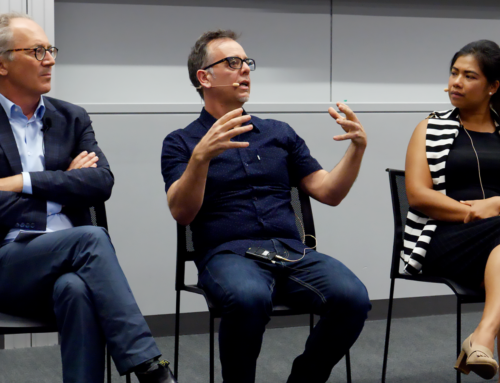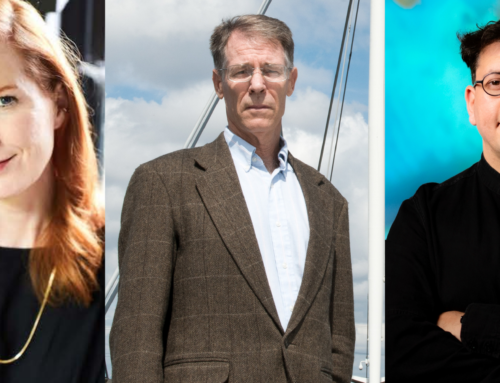Susannah Lai
The bulk of the Q Symposium takes place at the serendipitously named ‘Q Station’—the heritage-listed former Quarantine Station in Sydney, used from 1832 to 1984 to detain new arrivees from ships until it was assured that they did not carry any infectious diseases. Fittingly, both for a quarantine area and for the Q Symposium, which aims to provide a focused space for attendees to examine issues relating to quantum technology, Q Station is in a secluded, although not isolated, location.
The attendees arrived at Q Station by boat and were greeted with lunch and a traditional ‘welcome to country’ ceremony. The symposium then kicked off with the first panel, “The Quantum Race (Part 1)”, moderated by Professor James Der Derian joined by Professor Benjamin Eggleton, Professor Joan Leach and Dr Jingyun Fan. The focus of this panel was the state of the ‘Quantum Race’, how far various quantum technologies had developed, and the political and social implications of these.
Professor Der Derian introduced the panel by asking what ‘quantum’ means to the world, how it is perceived, what effects it has had and presented the fact that the ‘quantum age’ has spanned over two world wars. Moreover, he mused on where Project Q itself could lead, as it examines the inter-connectivity of interesting research.
Professor Benjamin Eggleton of Sydney University’s Nano Institute spoke first, primarily addressing the area of quantum computing. He explained that quantum computing is currently a very active field, with many different avenues of research being pursued in various locations. He gave examples from Google and IBM’s work on superconductors (an avenue with applications outside quantum computing), Microsoft’s work on topology, and his own work in the area of photonics.
Photonics is a huge area with substantial investment, the leader of which is Jian-Wei Pan of China. The scope of Pan’s research is certainly impressive; he has his own dedicated satellite, equipped with ground-breaking, secure-line communication driven by his experiments in quantum entanglement (a topic later elaborated upon by Jingyun Fan), and is planning to build a quantum link to the moon. Not coincidentally, the investment in his research is huge, in excess of most other areas.
In terms of building a photonic quantum computer, theoretical architectural pathways to its creation have been proposed, Professor Eggleton explained, but they rely on a material that does not yet exist. Theoretically, this material would allow photons to interact in a single channel, creating a ‘CNOT’ gate, with the system needing to be able to generate single photons on command. The current favourite solution is the ‘quantum dot’—a semi-conducting particle that is a only a few nanometers big—although its use will be difficult in Professor Eggleton’s opinion.
The next speaker, Professor Joan Leach of ANU, took the discussion in a different, rather more somber direction, musing on the potential ‘dark sides’ of public awareness with respect to evolving science and technology, quantum in particular. According to her, the general public want to be more involved in science, but quantum is especially difficult to communicate, in part due to the lack of intermediaries to interpret the technical jargon used by scientists in the field for laypeople outside of it.
Professor Leach then went on to comment, like Professor Waever from the previous night’s opening panel, on the distinct lack of adversarial research being done in this area. She speculated on whether this is hampered by the barrier of understanding between technical and laypeople in the quantum field and whether this barrier needs to exist at all. Perhaps, Professor Leach suggested, there is a level of deliberation in making quantum ‘strange’, using opaque jargon and overly complicated explanations, when it seems like quantum is just ‘really interesting and involved engineering’.
She then went on to question the need for the term ‘race’ to be applied to the development of quantum technology. She explained that there are multiple avenues of ongoing research, with multiple applications, signifying that quantum research and development does not truly fit the category of a ‘race’. However, if there is no ‘quantum race’, she asked, then why is there such a rush to develop, and is development being pushed forward safely?
With a lack in both law and policy, Professor Leach mused on the possibility of policy makers being the proverbial ‘police car’ chasing the scientist to make them slow down, while lagging in the actual framework and possibly hampering research unnecessarily while trying to construct it. She commented that Australia in particular does not have safe development frameworks, suggesting that perhaps Europe has solid examples on how to run checks and balances in research.
The last speaker for this panel, Dr Jingyun Fan, a researcher at the Joint Quantum Institute in China, brought the discussion back to the technical. As his research is associated with that of Jian-Wei Pan mentioned by Professor Eggleton, he expanded upon many of the topics that had been brought up previously. He also talked about further research topics that his team has been working, beyond the subject matter that Professor Eggleton had focused on.
Dr Fan’s first topic was the quantum space experiments that are being conducted, which focus on using quantum entanglement to achieve certain effects, like teleportation, or secure-line communication. Both these technologies aim at quantum key distribution, free of the risk of keys being intercepted. These are both rather fascinating; if the extremes of quantum theory are confirmed, and entangled bits flip at the same time, what is known as quantum teleportation can occur. In theory, this could break the general theory of relativity and with it, causality. However, the information carried is still contrained by the laws of physics at this stage.
In fact, Dr Fan said, even when entanglement is executed purely along ground-based lines, even with repeaters, it is very inefficient. Even with a 10ghz perfect single photon and 1000 km fibre (ideal conditions) it would take 300 years for the information to be transmitted via quantum entanglement. Once the researchers realized this, Dr Fan explained, they looked to other solutions, and found that the technical challenges were much reduced when using satellites, which allowed them to relay information between various ground stations over 1000km apart within a period of hours rather than years or centuries.
After Dr Fan’s talk, the floor was opened to questions. Most questions tended to the more ‘meta’ topics, and the way policies might affect the progression of the science, as well as how communication could be facilitated and if it even should be. The audience was also curious as to how willing scientists in the field were to have that happen.
Professor Leach fielded most of these questions, commenting that people were looking at new ways to structure innovation to get more benefit from innovation cycles, presumably implying that regulation could be structured to avoid impeding progress and speculating that truthfully, there was an active unwillingness among the scientific community to open communication to laypeople and the general public. A few technical questions to Professor Eggleton and Dr Fan followed, such as the difference between quantum computing and quantum communication and the expected return on investment. This was answered by Professor Eggleton, who explained the main differences, particularly with regard to security applications, and the major ROI expected, such as the increase in processing power, allowing simulations of the creation of new materials, or things like big data operations.
The question directed at Dr Fan was of particular note, bringing up the use of ‘cube satellites’, a light-weight, cheap alternative to conventional satellites that are popular for smaller scientific experiments that require space conditions. While he had not heard of the technology, and wondered if the battery power would be sufficient, he acknowledged that this would be a great way to advance quantum experimentations in space.







Leave a Reply